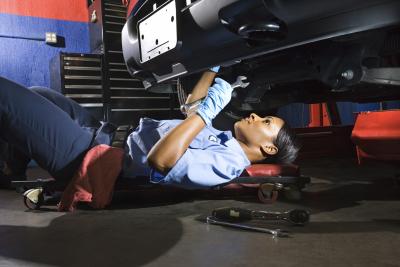
External wastegates are an investment that many turbo enthusiasts run to help control boost and tuning better than a stock internal wastegates may allow. Stock wastegates may be too small to prevent "boost creep" (an unintentional rise in boost pressure) on large displacement engines using big turbos and low boost levels. The upgrade itself is fairly easy, and is a good investment no matter what power level you're running.
A wastegate is essentially a bypass valve that reduces exhaust flow to the turbo. As turbo speed and boost pressure are directly tied to exhaust flow, installing a bypass will help to effectively limit turbo RPM. The important thing to understand about wastegates is that they must be large enough to allow sufficient exhaust to bypass the turbo, or you risk boost creep. Larger displacement engines with big turbos will require larger wastegates to eliminate flow. A 35 mm wastegate will suffice for most four cylinder applications, but you'll want to add about 1mm in wastegate diameter for every 15 cubic inches of displacement over about 200 ci.
Any good wastegate is going to require both a new up-tube and down tube. You can also modify your existing up-tube (the one your turbo mounts to), and down-tube (the turbo's exhaust pipe), but most wastegate manufacturers either directly sell or can point you in the direction of another manufacturer who makes bolt-on up and down tube replacements.
Putting everything together is fairly straightforward. Simply replace your stock up-tube and down-tube with those supplied by your wastegate manufacturer, and link the bypass ports on the two with your wastegate manufacturer. If you use a direct-mount wastegate (the kind that sandwiches in between your turbo and up-pipe mounting flange), then you're going to have to weld the wastegate's bypass tube to your down-pipe.
If you're modifying and fabricating your own bypass system, then take a good look at commercial applications available for similar engines. The wastegate's intake tube should be connected in a tight "V" to the up tube, and and should bend smoothly toward the down-tube. After installing the wastegate, connect its output tube to the down-tube in as smooth a way as possible. Remember, this is a bypass, and a bypass tube that is as straight as possible with smooth bends will flow the best.
There are a lot of ways to control your wastegate's opening, and almost all aftermarket wastegates will have some way to adjust their activation pressure. However, serious-power applications should consider a stand-alone electronic boost controller that will allow you to reduce pressure incrementally before the bypass is completely opened. This will make your engine a little more forgiving and easier to shift at the red-line.